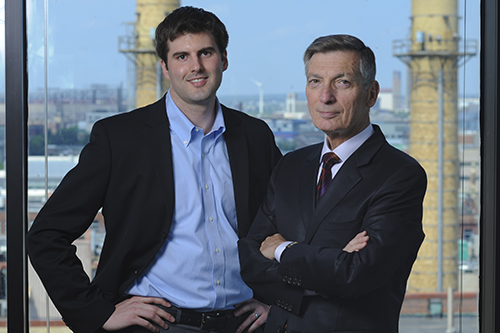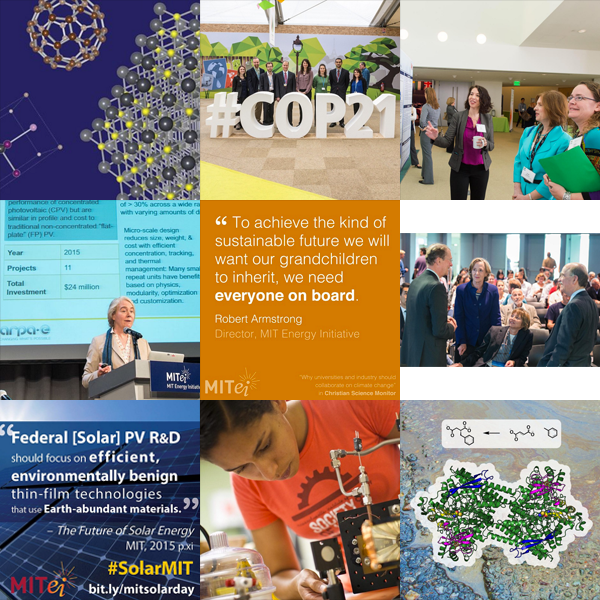
2015 brought many exciting advancements in energy for the MIT community, which MITEI has been sharing on our website and through social media. Articles and tweets our readers and followers have enjoyed have included an MIT graduate’s global journey in a solar-powered plane, the MIT Tata Center’s work bringing clean energy to India, and stories on groundbreaking nuclear energy technologies. With the year culminating in the Paris climate talks, we created a special section of our website featuring articles and social media related to MIT involvement in COP21, which attracted and engaged many readers.
Here are some of the 2015 MITEI articles and tweets our readers found most interesting. Let us know your favorites with #TopMITEI2015 on Twitter.
Releasing The Future of Solar Energy
In May 2015, MITEI released The Future of Solar Energy report in Washington, D.C. The result of years of research and collaboration between researchers across MIT, The Future of Solar Energy investigates the potential for expanding solar generating capacity to the multi-terrawatt scale by midcentury. Energy storage, large-scale deployment, and solar photovoltaics technologies were among the areas of cutting-edge MIT research discussed in the study. To involve the MIT community, MITEI held Solar Day in September, an event on campus to share the wealth of solar research happening at MIT with students, faculty, and others across all disciplines. The study is the latest of seven multidisciplinary MIT reports that examine the role that various energy sources could play in meeting energy demand in a carbon-constrained future.
How the world can move toward affordable #solar energy: http://t.co/wABj5oXXZc via @mitenergy pic.twitter.com/1GaW816cr2
— MIT (@MIT) May 9, 2015
5 takeaways from our #FutureofSolar study, courtesy of @btschiller @FastCoExist http://t.co/RZlUGWGOU7 #solar #energy #MITEI
— MIT EnergyInitiative (@mitenergy) May 13, 2015
Residential vs. Utility Scale #Solar: Read @chriscmooney on MITEI’s Future of Solar #Energy Study http://t.co/tP00GoRadJ via @washingtonpost
— MIT EnergyInitiative (@mitenergy) May 8, 2015
Developing a solar cell from discarded car batteries
Angela Belcher, the James Mason Crafts Professor in biological engineering and materials science and engineering, and Paula Hammond, the David H. Koch (1962) Professor in Engineering, along with Po-Yen Chen PhD ’15 (now at Brown University) and a team of researchers, are using old lead-acid car batteries as a materials source for solar cells. Lead from the abundant recycled batteries can be used to make high-efficiency, low-cost solar cells.
.@MIT researchers are making #solar cells with recycled lead from discarded car #batteries https://t.co/ZqV88ZLJRJ pic.twitter.com/9CmPCwqDJL
— MIT EnergyInitiative (@mitenergy) December 23, 2015
Sharing MIT climate research and strategies at COP21
During the Paris climate talks, members of the MIT community in attendance acted as expert resources on the science and policy behind climate change, discussed potential solutions to global climate and energy challenges, and joined others from around the globe to underscore the importance of transitioning to a low-carbon energy future and reaching a global agreement to limit greenhouse gas emissions. Professor Jessika Trancik, whose report on the mutually reinforcing relationship between technology improvements and emissions reductions was recently released, shared her research with the White House, U.S. Department of Energy, and others to inform COP21 discussions. MITEI reported from Paris on MIT events and other activities at COP21, including Professor John Sterman and Climate Interactive’s live public simulations in which participants took on the roles of climate negotiators. MIT undergrad Joseff Kolman joined a handful of MIT graduate students attending the talks as part of the MIT delegation.
.@MIT at #COP21 – Sharing climate research & strategies https://t.co/53MR9HlKyX @MITGlobalChange @MITSloan @mitidss pic.twitter.com/Xq1KWLhkdS
— MIT EnergyInitiative (@mitenergy) December 12, 2015
MIT’s Jessika Trancik: #COP21 consensus can reduce cost of future emissions cuts https://t.co/9AjqXFq5oX @csmonitor pic.twitter.com/eGMScIa7Ci
— MIT EnergyInitiative (@mitenergy) December 10, 2015
Climate negotiation role-play in Paris: diverse participants adopt new perspectives https://t.co/5ZhXt5NVye #COP21 pic.twitter.com/5sROoHcGRN
— MIT EnergyInitiative (@mitenergy) December 7, 2015
Right now at #COP21, members of public doing live simulation where they play negotiators w/@climateinteract & @MIT pic.twitter.com/Gsj2AP7Mir
— MIT EnergyInitiative (@mitenergy) December 4, 2015
Meet @JoseffKolman, an MIT undergrad at the Paris climate talks https://t.co/AgyEDpI003 #COP21 pic.twitter.com/7ROg8EX6v5
— MIT EnergyInitiative (@mitenergy) December 1, 2015
Giving nuclear energy a new look
MIT-developed nuclear energy research is changing the way people think about the future of nuclear energy. The autumn issue of Energy Futures included a story about a team of MIT researchers developing a floating nuclear power plant. National Geographic honored MIT alumna Leslie Dewan, founder and CEO of the new-age nuclear power company Transatomic, as one of a select group of National Geographic Emerging Explorers, “young trailblazers whose ideas are helping to change the world.” MIT’s nuclear fusion research also garnered media attention: Andrew C. Revkin, of the New York Times DotEarth column, wrote about the breakthrough work of the MIT Plasma Science and Fusion Center in helping to bring the world closer to workable fusion technology.
The coolest person in #nuclear #energy now, according to @NatGeo, is an @MIT alum http://t.co/9wKXJzobij @MIT_alumni pic.twitter.com/Gw1mpBYazu
— MIT EnergyInitiative (@mitenergy) June 16, 2015
#IronMan, #fusion on our site today, thanks to @MIT_Fusion‘s Whyte and @MITstudents http://t.co/CpLsGE7kqG @dotearth pic.twitter.com/7y1V0R1BQI
— MIT EnergyInitiative (@mitenergy) August 12, 2015
Bringing clean energy to India with the MIT Tata Center for Technology and Design
In 2015, the MIT Technology Review dedicated a cover story to India’s energy challenges and opportunities, focusing on the Tata Center’s work there. The 2015 Tata Center Symposium brought together energy and development experts from around the globe in discussion at the MIT Media Lab. At the ARPA-E Energy Innovation Summit, Tata Trusts Chairman Ratan Tata and U.S. Secretary of Energy Ernie Moniz shared the stage to discuss energy, transportation, and economic development, especially problems of rural energy distribution. The MIT International Science and Technology Initiative, MISTI, has also played a major role in connecting the MIT community with India, as in the case of MITEI Energy Studies minor Cecilio Aponte ’15 who spent a summer there working for Solar Electric Light Company (SELCO).
Great long read on #India‘s energy challenges and opps, incl. work w/ @TataCenterMIT http://t.co/S4ZNYW8BZg – @RMartinBoulder @techreview
— MIT EnergyInitiative (@mitenergy) October 7, 2015
.@TataCenterMIT Fellow Katie Taylor, CEO of @khethworks, designs #solar-powered irrigation systems for Indian farmers pic.twitter.com/gsYWy7H2rm
— MIT EnergyInitiative (@mitenergy) September 29, 2015
Cecilio Aponte, 2015 #energy studies minor grad, discusses his #solar research in India http://t.co/OCSADbGequ @MISTIatMIT @MITstudents
— MIT EnergyInitiative (@mitenergy) August 4, 2015
Secretary of @ENERGY Ernie Moniz and @TataCenterMIT‘s Ratan Tata brainstormed #energy innovation at the @ARPAE Summit http://t.co/iN5COvulNc
— MIT EnergyInitiative (@mitenergy) February 19, 2015
Advancing women’s participation and leadership in clean energy
The 2015 Clean Energy Education and Empowerment (C3E) Women in Clean Energy Symposium was a huge success. Women leaders in energy from across the nation, including nine who were honored at the event for their leadership and achievements in the clean energy field, met to share innovative ideas from many different disciplines. Following the event, the U.S. Department of Energy, MITEI, and the Stanford Precourt Institute for Energy announced that the Precourt Institute will join DOE and MITEI in sponsoring the event and advancing women’s leadership in clean energy. The 2016 C3E Symposium will be held at Stanford in late May 2016.
Introducing the 2015 #C3Ewomen awardees: #cleanenergy leaders in industry, gov, academia: https://t.co/1p6O4qGde0 pic.twitter.com/sN5Q4SaYKN
— MIT EnergyInitiative (@mitenergy) November 5, 2015
Analyzing and modeling energy solutions
MIT professors also made major contributions to analysis and modeling of energy solutions in 2015. Georgia Perakis, the William F. Pounds Professor of Management at the MIT Sloan School of Management, used operations research and operations modeling to gain access to better energy data. A team of MIT researchers assessed the potential of Tesla’s newly released Powerwall battery. And MIT as a whole unveiled a new forecasting tool to aid in the Institute’s energy planning.
Designing a high-capacity battery of molten metals
Materials Science and Engineering professor Donald Sadoway, MIT alum David Bradwell and their collaborators have developed a low-cost, high-capacity, efficient, long-lasting, easy-to-manufacture battery—a combination of traits that make this novel battery technology ideal for energy storage on today’s power grids and in the future.
Inspiring the next generation of energy pioneers
One of the most important parts of MIT’s mission is to educate the science and policy leaders of tomorrow, and 2015 was a banner year for energy breakthroughs by both current students and alumni. In one standout story, MIT grad Andre Borschberg was part of a two-pilot team that began circling the globe in a completely solar-powered plane. He and adventurer Bertrand Piccard took turns at the controls, changing at stopovers as varied as Ahmedabad, India, Nagota, Japan, and Hawaii. At each stopover, educational events such as conferences and school visits were held to raise public awareness of the flight. After a break for repairs, the second half of their round the world trip is scheduled to commence in April 2016.
#MIT grad co-pilots plane circling the globe without a drop of fuel http://t.co/V4WmJ9HnPL @MIT_alumni @solarimpulse pic.twitter.com/ZSoGGvGkYK
— MIT EnergyInitiative (@mitenergy) March 10, 2015
Celebrating interdisciplinarity in research
MITEI engages with professors and students from all schools and departments at MIT—in fact, thirty percent of all MIT faculty is engaged in energy-related research and education efforts. Similarly, in our research we focus on all areas of the energy spectrum, from the electric grid to low-carbon energy technologies and more efficient conventional energy technologies. So when Nature debuted a cover celebrating interdisciplinarity and asked readers to share photos of it, we knew we wanted to participate and include a slice of MITEI: Energy Futures.
We’re all about interdisciplinarity @MIT! @NatureNews #energy #InterdisciplinarityNatureCoverOnTheWall pic.twitter.com/XTevhWdmSe
— MIT EnergyInitiative (@mitenergy) September 18, 2015
Sharing energy moments on Instagram
In 2015, MITEI started sharing energy research, education, and event photos on Instagram. Check out our #2015Best9 and follow next year’s great moments in energy @mitenergy.


